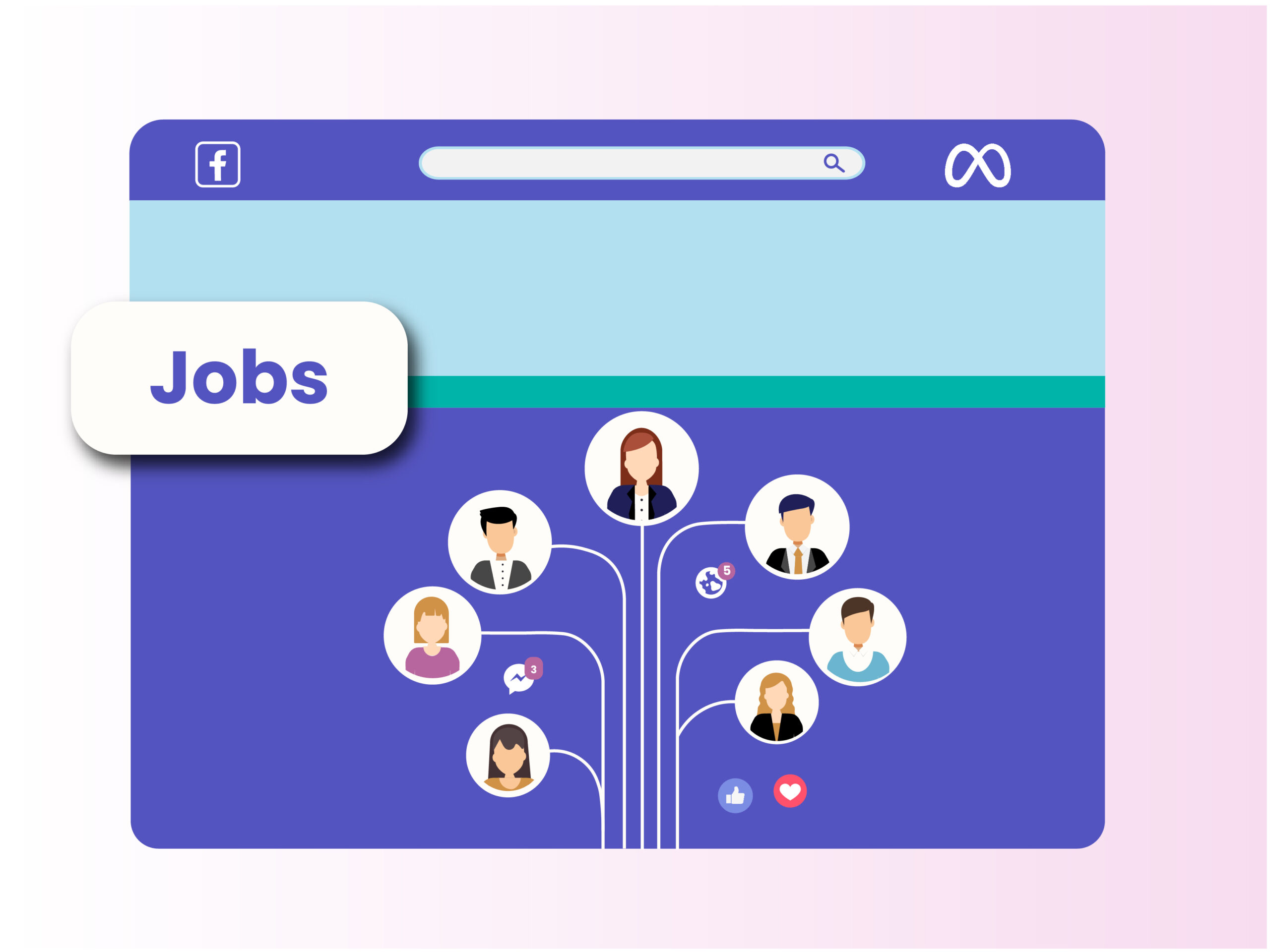What is Recruitment Advertising?
Recruitment advertising is the practice of using job advertisements to attract, engage, and hire talent. It encompasses advertising strategies, processes, and technologies that enable recruiters to reach the right people at the right time and to build a steady pipeline of talent. It is by far the most efficient way to generate a worldwide candidate pipeline that can be converted in minimal time.
Why is Recruitment Advertising Important?
The search requires more nuance
The market for talent has been flipped on its head. The recruitment challenge these days is not about a lack of available talent; it is about finding and attracting the right talent. Recruitment advertising enables talent hunters to reach very specific candidates.
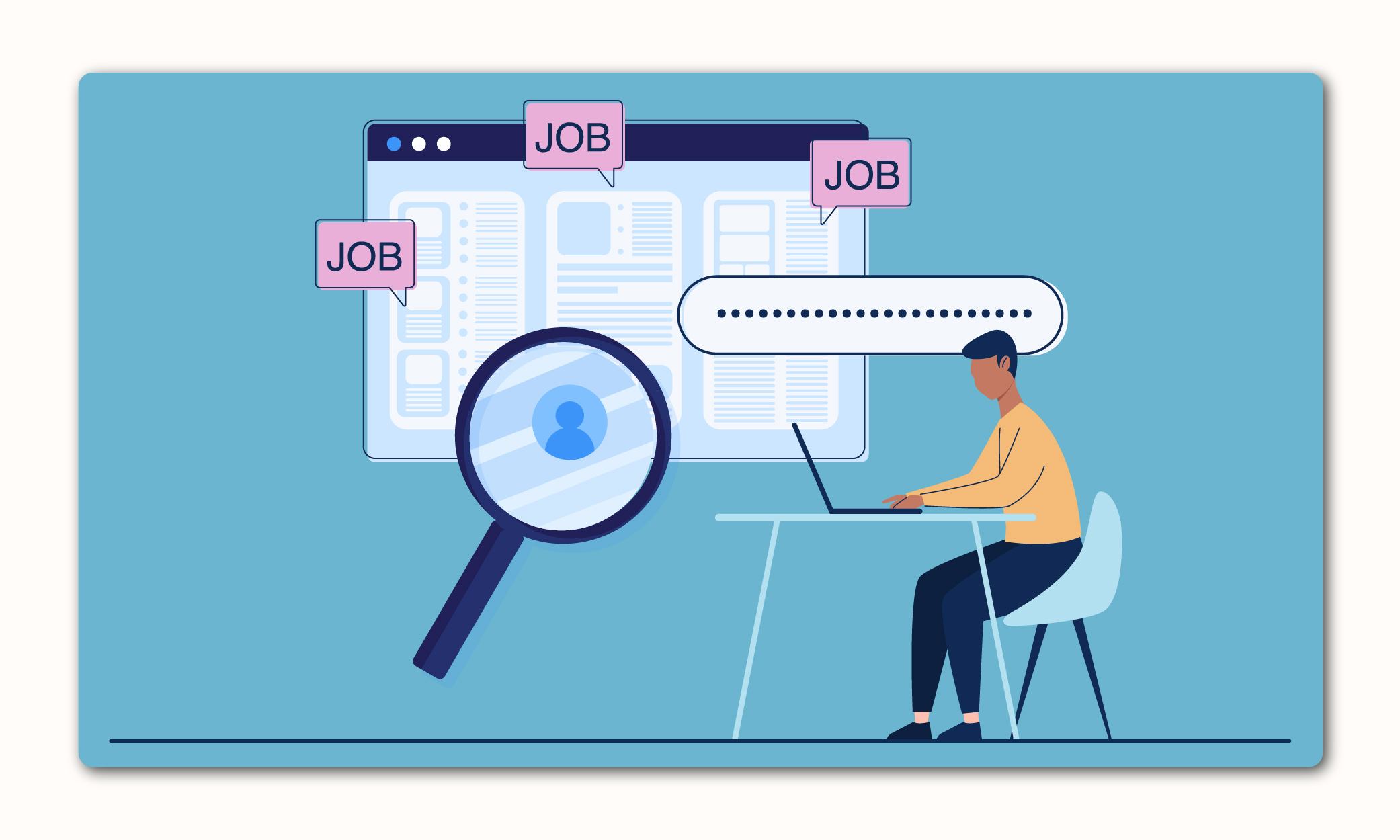
Recruitment needs to be proactive
Recruitment advertising is a long-term plan and cannot be done ad-hoc any longer. You’re searching for candidates of the highest quality and not just based on their availability. Employers need to build a talent pool of active and passive candidates. The right recruitment advertising strategy will help you track your recruitment efforts’ effectiveness and also help you prioritize your resources and time.
An employer brand is critical
No matter how essential, a job is not just a transactional aspect of our lives any longer. For employees of this generation, it is imperative that they connect to the company’s ethos. Hence, it has become increasingly important for brands to maintain their presence in front of potential candidates continuously. Employees look forward to relating to the organization’s mission that they are working for. What does this mean for employers? Recruitment advertising helps leverage the right content at the right place and the right messaging when it comes to brand communication.
What are the Benefits of Recruitment Advertising?
Done right, recruitment advertising helps improve the entire recruitment process, from the candidate experience to the brand image. Here are the top five benefits recruiters can expect when making the switch.
Cast a wider net
The most significant benefit of recruitment advertising is eliminating the limitations of location, partner, channel, or network. Traditionally, employers tended to have individual contracts with a handful of agencies, job boards, RPOs, etc., to advertise their job openings. This limited their audience exposure and automatically filtered out potential candidates who weren’t accessible via these channels. Moreover, this approach’s “spray-and-pray” nature meant that you had no control over either the number or quality of applicants. On the other hand, recruitment advertising enables recruiters to reach candidates with specific qualifications wherever there may be.
Improve candidate quality
Recruitment advertising not only targets specific, highly relevant candidates, it also helps mobilize “passive” talent – or suitable candidates who are not actively looking for jobs. The truth is, passive candidates are not necessarily as passive as you’d think. Many people just need a gentle nudge to consider new opportunities. (Millennials, in particular, have an average job cycle of about two years.) Recruitment advertising is a way to craft a specific message that will attract all possible candidates. This improves the quality of applicants and the speed of the hiring process.

Diversify your workforce
Since recruitment advertising involves targeting specific candidate personas, it allows organizations to create personas that proactively build inclusive workforces. For instance, personas that factor in gender, cultural, racial, or religious diversity can help employers ensure the formation of a top-quality– and highly–diverse–workforce.
Give candidates a superior recruitment experience
Recruitment advertising helps you craft highly personalized content for every target candidate at every stage of the hiring process. From pre-applicant to the hiring stage, you can customize your messaging at every touchpoint based on whom you’re targeting and where you’re reaching them. This enables you to place candidate experience at the center of all your efforts.
Reduce hiring costs
With traditional recruitment practices, recruiters have little control over spending because results are unpredictable. There is a lot of money wasted on talent acquisition, and even worse, it is impossible to track where money was misspent. Recruitment advertising gives you far greater visibility into channels that have yielded the best results. This helps you prioritize your recruitment budget and minimize waste. It also helps save time and money by building and nurturing a rich, promising database of future candidates.
Make your candidate database work for you and create experiences that convert. Meet MOJO Talent Engage CRM.Struggling to Build Meaningful Relationships with Candidates, Across Channels?
How Has Recruitment Advertising Evolved?
Thanks to technological evolution over the past several decades, job ads have come very far from where they began. So how did they start? How did we end up here? It’s a fascinating story.
The first job ads were handwritten “Help Wanted” notices tacked to community bulletin boards, office windows, or restaurants. Their audience was pretty much just people who happened to walk by. The 19th century brought newspapers, which quickly became a powerful vehicle for mass communication. The first published classified job ads – paid per word – soon appeared in newspapers, magazines, and other print publications. This was a vast improvement over bulletin boards and window notices because employers could reach far more potential candidates over a much wider area. There were, however, limitations to these ads. They were both expensive and only supported one-way communication.
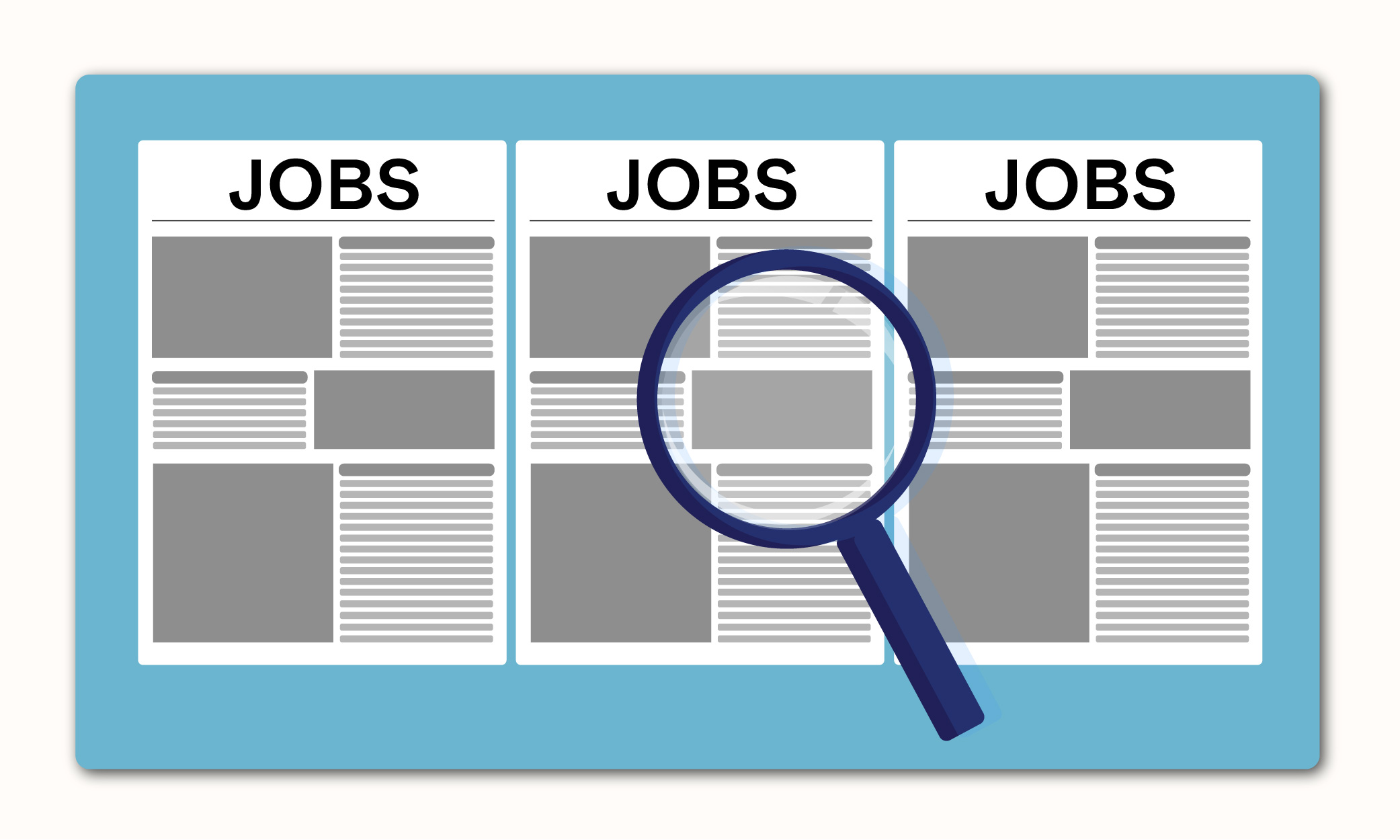
The 1950s brought television and radio, where employers paid per spot for each ad. These were also expensive but still by far the best way to achieve mass reach until the Internet ramped up in the 1990s. The first online job boards appeared in the mid-1990s, revolutionizing how employers could reach candidates.
With job ads moving online, geographical reach soon became irrelevant. Audience reach skyrocketed, costs dropped, and response times shrank. Job boards gave recruiters access to nearly any candidate anywhere, at any time. Despite this, the first job boards were relatively primitive. They consisted of plain lists of job ads with no cohesive application process. Data was not yet being leveraged. Like job listings, job ads were displayed with little strategic targeting.
Finally, early 2000s job boards launched the first pay-for-performance model – pay-per-click ads. This model led to the rise of job aggregators such as Indeed and Simply Hired by the mid-2000s. By the end of the decade, job advertising advanced in the digital space, with increasingly advanced technologies that catered to an ever greater demand for aggressive recruiting. Social media recruiting had also emerged, chiefly led by LinkedIn.
Recruitment Advertising Today
Job seekers are online. The way job seekers find and apply for jobs has changed forever. The Internet, mobile devices, and social media have pervaded every part of our lives, and therefore, traditional recruiting activities – the old method – yield little to no results. Candidates are now “consumers” that discover and check out potential employers online, the way they would a product or service.
As a result, data is now indispensable to recruitment. With growing pressure to step up efforts – often with the same budget – talent acquisition must be efficient. Traditional recruitment practices are not built to incorporate large-scale, real-time data. To ensure the yield of candidates is predictable, recruiters must leverage all available data. Attention to data has led to the birth of several intelligent automation solutions. The most significant of these solutions is programmatic job advertising
What is the Recruitment Advertising Process?
There is no specific one-size-fits-all formula for a successful recruitment advertising process. One of the best things about recruitment advertising is defining success based on your specific recruitment goals. Here are four steps that can help you achieve your targets.
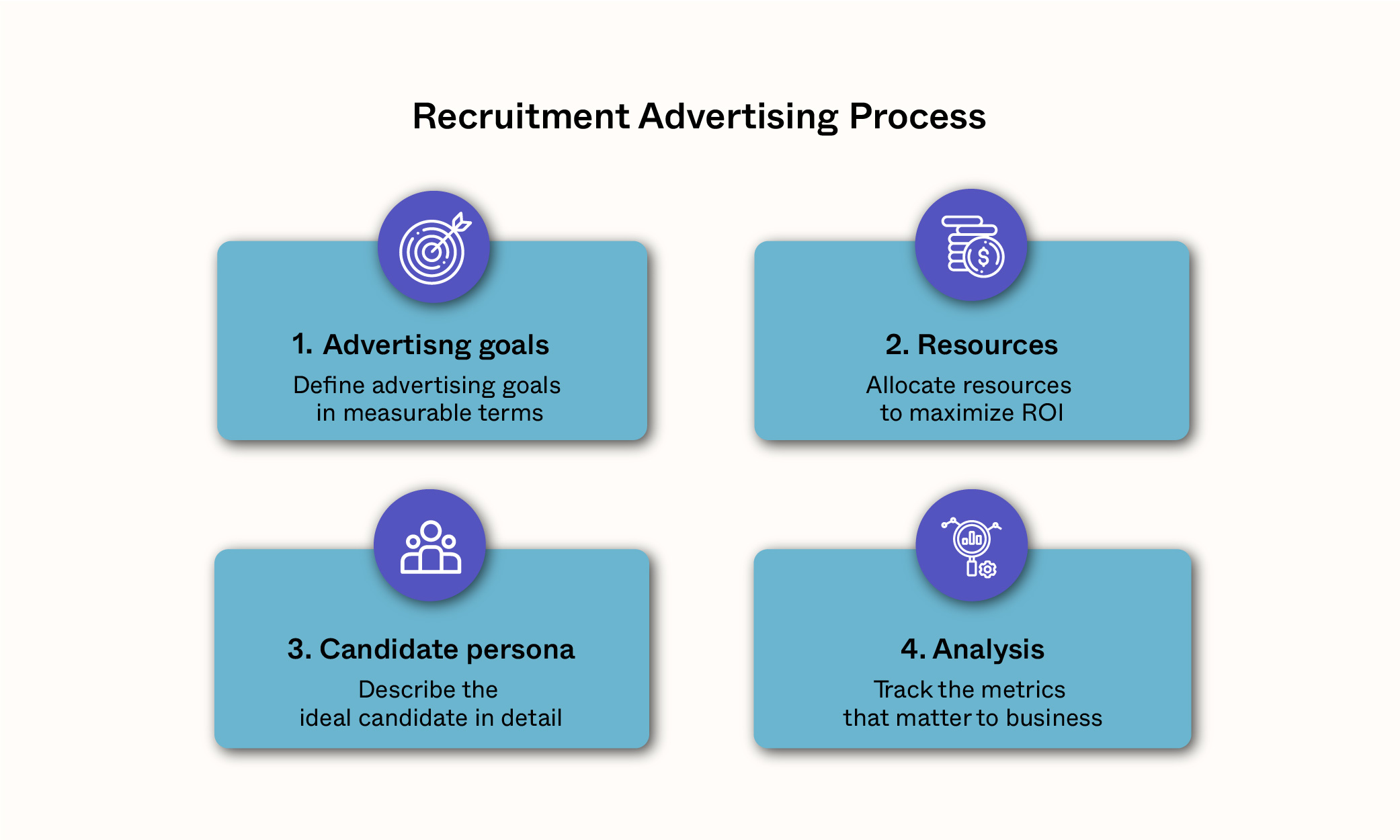
Step 1: Define your advertising goals
Think about what you want to achieve in measurable terms. Sure, excellent candidate quality is a given, but what’s your budget to achieve it? Is diversity a factor? If yes, you’ll need to set it as a mandatory rule. For example, a few common recruitment advertising goals would be: find x more qualified candidates, reduce cost per hire by $x, boost impressions by x%, fill a vacancy in x days, get x more applications per ad.
Step 2: Describe your candidate persona
Who would your ideal candidate be? (The more detailed, the better!) Look beyond typical job requirements such as experience, education, and skills. Focus on getting a deeper feel of the person you’d like to hire. What are their interests outside work? What motivates and inspires them? A few criteria to consider are current job, geographical location, key skills, hobbies and interests, likes and dislikes, motivations and aspirations, brands they follow, intellectual inclination (creative/analytical), age, and so forth.
Step 3: Allocate your resources
Once you’ve defined your goals and outlined your candidate persona, it’s time to allocate resources. How you distribute your resources is an essential step to maximizing your ROI. One best practice is to focus more on bottom-funnel metrics, such as cost per application and cost per hire, rather than on vanity metrics such as cost per click.
Step 4: Track your progress
No plan is complete unless you analyze its performance. This is where data plays a critical role. Since your goals are unique to you, there’s no way you can define success by measuring against industry standards – which can only help you analyze your standing competitively. To measure success against your unique goals, you need to develop a baseline of your key metrics and data. You can then track progress against these metrics to accurately analyze performance.
How to Select the Ideal Recruitment Advertising Channel Mix
Sourcing talent is the first step in your talent acquisition process. While it’s important to keep filling up the top of the recruitment funnel to ensure a sufficiently large pipeline, it’s even more critical to ensure that you attract the top talent available.
In these times, recruiters are swimming in sourcing channels. The challenge has shifted from lack of available talent to figuring out where to find best-fit talent. The goal is to intelligently distribute your sourcing efforts across multiple channels to bring in a large and diverse pool of candidates. Choosing a sourcing channel depends on many other factors beyond attracting top candidates, however. These include budget, type of role, the urgency to fill, and volume/frequency of hiring.
Here’s a comprehensive guide to sourcing channels, including what each of them is best suited for:
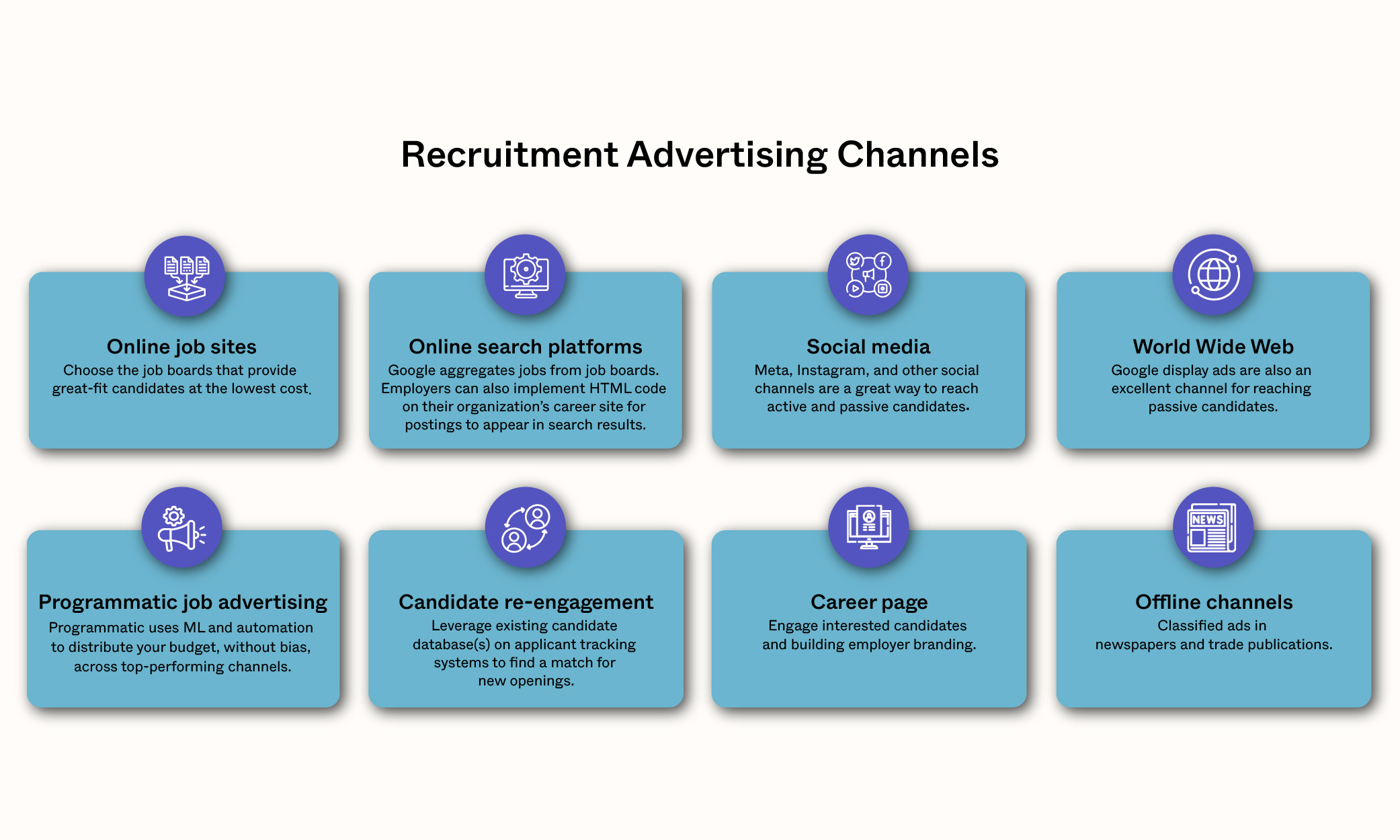
Online job sites
An obvious choice. This is the first place everyone starts looking when filling a vacancy. Sixty percent of job seekers begin their job hunt through job boards. It’s a no-brainer that employers need to establish a strong presence – both organic and paid – on top job boards like Indeed, Monster, and Glassdoor. However, one of the common concerns with this channel is that it attracts an inconveniently large volume of applicants, many of whom are poor quality or not relevant. This problem can be partially addressed by posting your jobs on niche, industry-specific job boards such as Nurse.com for nurse practitioners, GitHub for IT professionals, and Dice.com for technology specialists. These job boards tend to attract more relevant candidates (albeit fewer) at a lower cost.
A common challenge for recruiters is the hassle of managing numerous job boards. Posting jobs, tracking applications, evaluating performance, reporting, etc., across multiple job boards can be a painful process. So, unless you have a large team of recruiters to bear the load, you’d perhaps be better off relying on just a few high-performing ones.
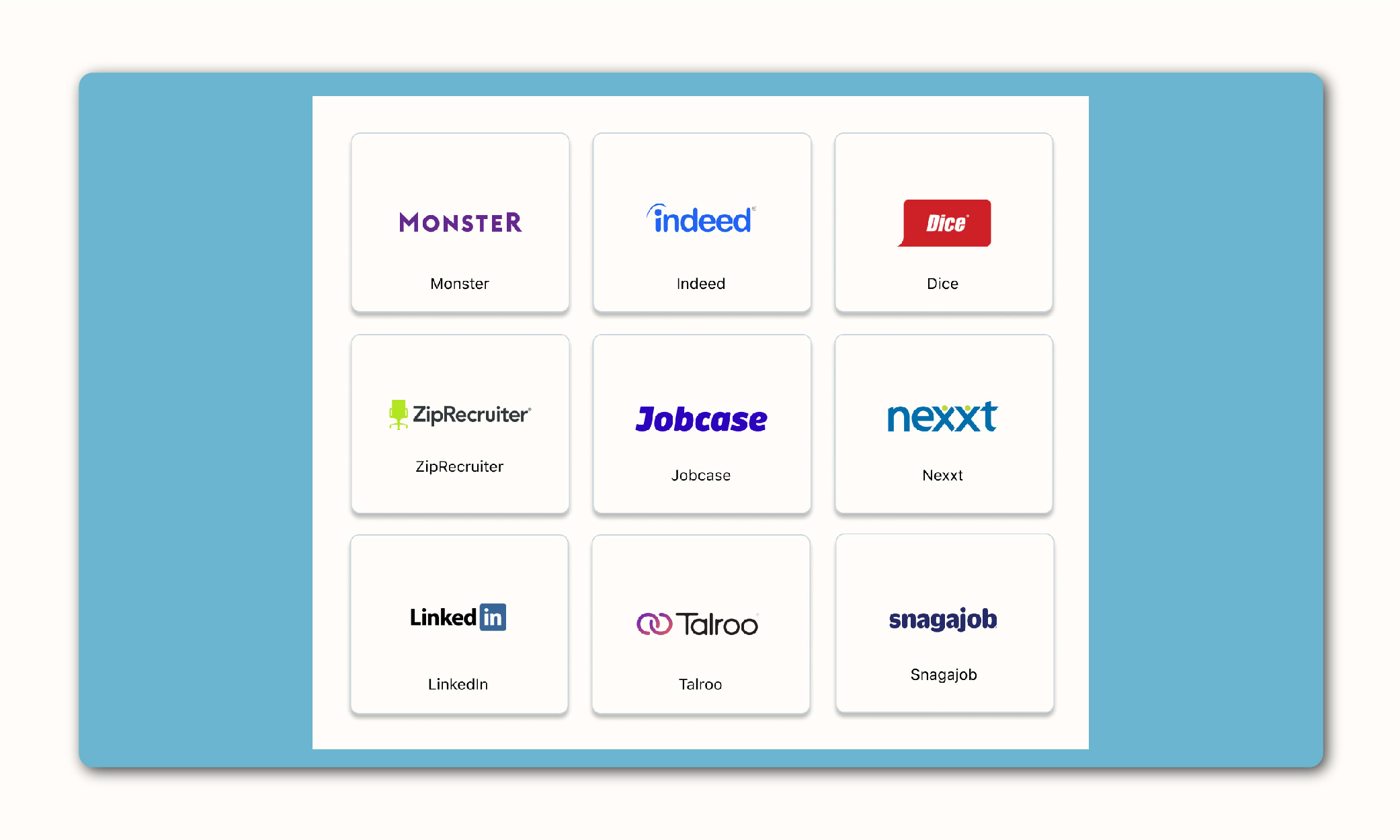
Online search platforms
Online search engines like Google can be powerful channels to reach a wider audience of job seekers organically. The number of job-related searches performed on Google each month in the US alone is somewhere between 50 and 150 million. To cater to this massive audience, Google for Jobs aggregates and organizes job postings from job boards and career sites and displays them prominently in its search results. This feature also enables candidates to find jobs of interest easily using a range of search options and filters. Consequently, Google delivers significantly higher conversion rates than other channels for certain types of jobs.
Employers cannot, however, directly post their jobs on Google for Jobs. It is only an aggregator. So, they must post on individual job boards, which Google then aggregates for display in its organic search results. Alternatively, employers can implement HTML code modifications on their career sites for their job postings to show up on Google.
Social media platforms
Social media channels – notably LinkedIn and Meta– are attractive yet underutilized platforms for reaching both active and passive job seekers. LinkedIn dominates online professional networks and boasts over half a billion members. Whether it’s through job listings (free or paid), trusted referrals, or elicited network recommendations, LinkedIn helps you land high-quality candidates – even for senior positions, such as vice presidents and directors.
World Wide Web
Google display advertising is another excellent channel for reaching passive job seekers across the internet. This works by publishing job advertisements on websites, apps, and other online platforms that job candidates frequently visit. The network reaches over 90% of internet users and has powerful targeting and retargeting capabilities.
Programmatic job advertising
Programmatic job advertising leverages a rules-based, machine learning-driven approach to buying recruitment media. In other words, your job advertising spend is spread without bias across top-performing online candidate sourcing channels – job boards, social platforms, search platforms, etc. – attracting highly relevant and qualified candidates in the least time possible. Thus, you end up with the best results, even as you minimize your cost per hire (CPH) and cost per applicant (CPA). Finally, programmatic advertising eliminates the need for you to buy media individually (and manage several contracts) for multiple sourcing channels, while also offering you access to highly-targeted and effective sourcing sites that you may not even know existed.
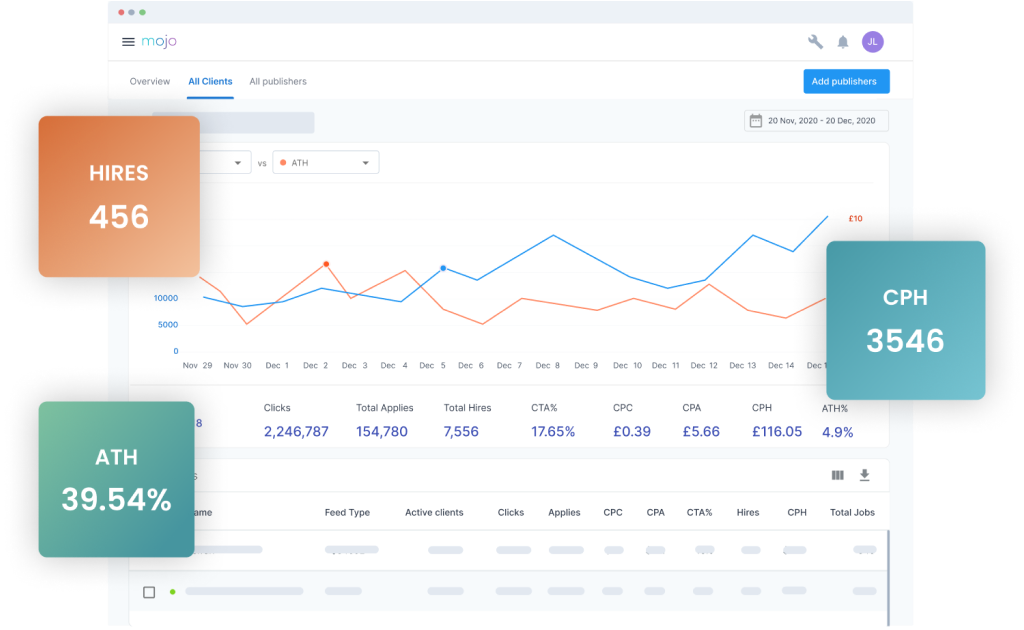
Also called candidate rediscovery, you can leverage the existing candidate database in your applicant tracking system (ATS) to find a match for new job openings. Any matches found may be used to target rediscovered candidates with push ads (display ads) or e-mail campaigns. Along similar lines, ex-employees, too, may be retargeted (these are called boomerang candidates). In addition, you could use display ads for retargeting candidates who have dropped off from your application process.
Re-engaging candidates is a missed opportunity for many companies – even though it helps build a more robust talent community and employer brand. That’s why it’s a best practice to start a candidate search with those that you’ve already deemed fit to work for your company in the past (the fact that it fast-tracks the entire hiring process is an added benefit).
Career page
A careers page on your website is a critical (and practically free) first step to excellent employer branding and recruitment. It’s incredibly effective given that it works mainly via pull rather than push. In other words, visitors already have some level of interest in you (as opposed to ones that you are trying to net). Career pages also offer the opportunity to share company values, culture, and benefits. This makes it easier for the candidate to evaluate the opportunity and decide whether to apply. This channel will also lend credibility to your business and help you maintain a strong, low-cost, talent pipeline.
Learn the tricks to adding a personal touch, being adaptable, and creating a user-friendly experience to keep potential candidates hooked.
Turn Your Career Site Into a Talent Magnet!
Offline channels – Trade journals/newspapers
While declining in relevance, this channel still helps you gain access to a sizable portion of candidates. For instance, what started as “Help Wanted” ads in the classifieds sections of newspapers back in the day still holds sway when finding candidates for blue-collar jobs such as plumbing, mining, gardening/landscaping, and heavy machine operations. Ads for such positions may also see a more relevant audience in specific industry/trade publications.
Given the wealth of sourcing channels available today, it’s no wonder that talent acquisition professionals have problems finding suitable sources. Scouring across all these channels for each open job can add to the complexity. The proper channels must be activated based on the importance and urgency of hires and budget. The ideal approach is to leverage technologies that automate the process and adopt an agnostic approach to selecting the proper channels.
What are the Types of Recruitment Advertising Media?
Once you have identified the relevant channels, it is time to consider the type of recruitment ads you should purchase. Ad choice primarily depends on hiring volume, budgets, and job types.
With a wide variety of recruitment advertising media at your disposal, the idea of selecting a few types can be overwhelming. The fact that all of them come structured at different cadences, price points, and returns doesn’t make the job any easier. To get a handle on the types of recruitment advertising media here’s a list of the more popular purchase options among leading job advertising professionals.
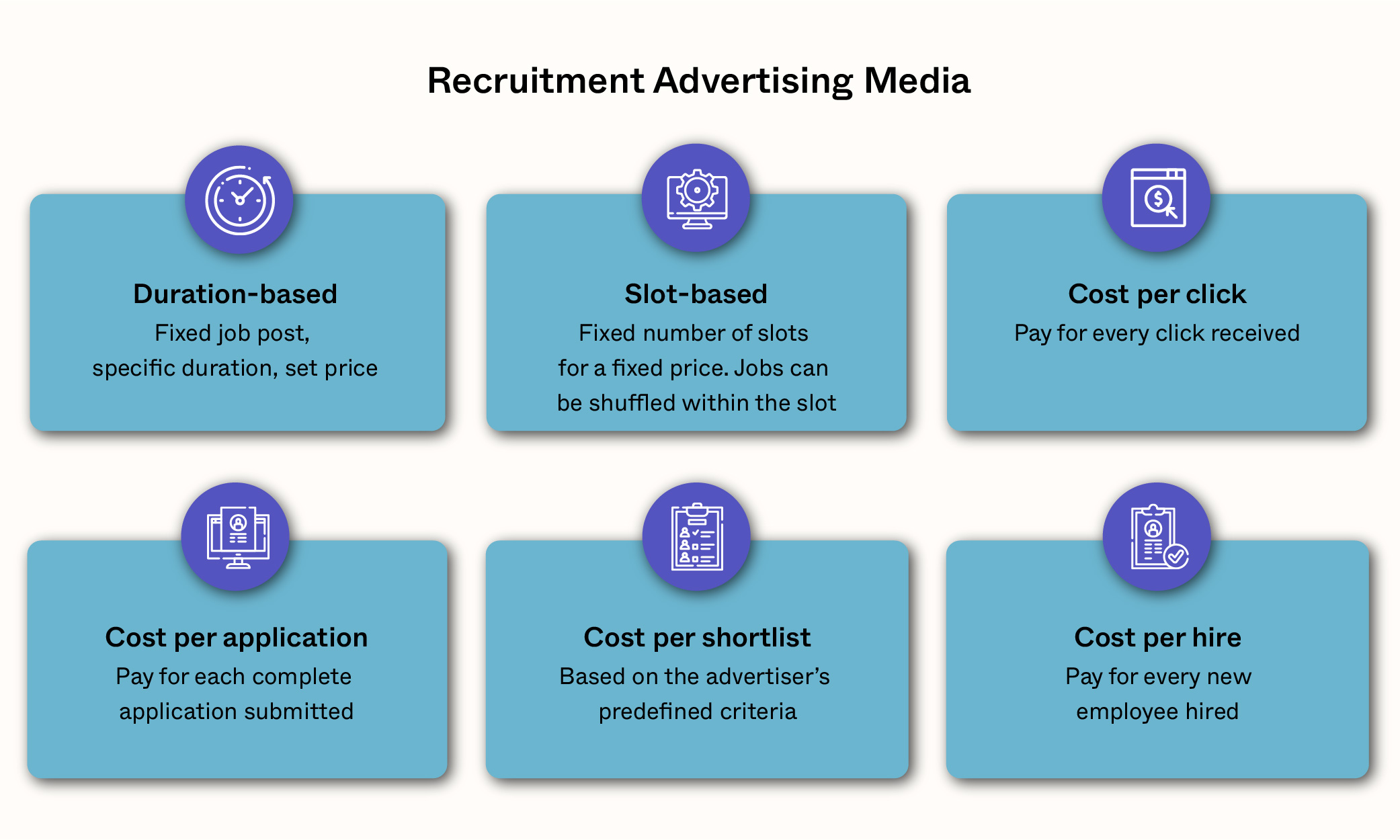
Duration-based posts
These posts run for a fixed duration of time (usually 30 days), for a fixed price. While most job boards offer broad exposure at a relatively low cost, there is a real threat of receiving an abundance of irrelevant applications – particularly from candidates applying in bulk to multiple postings. Further, they do not allow for much customization. If the job post is filled before the duration of the job ad, the remaining cost is wasted.
Slot-based posts
Here, advertisers purchase a fixed number of advertising spaces, at a fixed price, from one or more publishers. It’s like renting digital real estate for a specified period. Though the cost per job slot tends to be higher than the cost of a duration-based posting, you may choose to run any number of job ads for any number of openings throughout your purchase. The only drawback is that you can only run one job ad at a time for each slot. While undeniably more cost-effective than the rigid, duration-based attempts (that must run their course of time) slot-based posts are still a long way from offering the flexibility of performance-based pricing.
Cost per click (CPC)
Also called pay per click, this model allows advertisers to pay a fixed price for every click they receive on their job ad – or set a daily or monthly budget that translates into a definite number of clicks. This is a step in the direction of performance-based pricing (though the merit of counting a mere click as performance is arguable). Since you only pay per click, the publisher is responsible for displaying your ad in the most prominent way possible. The most crucial drawback of this approach is the inability to account for – or do anything about – irrelevant clicks.
Cost per apply (CPA)
An improvement over CPC, CPA allows advertisers to pay every time a candidate submits a complete application for a job ad. This is also a valuable metric that helps advertisers analyze how much they have to spend to acquire a candidate. CPA offers job advertisers a vastly better ROI while allowing them to align their ad spend better with their recruitment goals – whether in terms of candidate quality, time to hire, or cost. CPA has revolutionized recruitment advertising, allowing TA professionals to gain much-needed control over spending and significantly reduce their overall cost per hire (CPH).
Cost per shortlist (CPS)
Primarily used by staffing agencies and RPOs, this is when job advertisers pay every time they acquire a qualified applicant who meets the advertiser’s pre-defined screening criteria. Since the definition of a qualified candidate is up to the employer, this model affords an easy way to acquire a great-fit candidate pool, making for a much faster time to hire.
Cost per hire (CPH)
In this model, advertisers pay for every new employee they acquire. This is, arguably, the most effective way to analyze recruiting efficiency. While this approach undoubtedly allows maximum spend control, it can encourage an unhealthy focus on cost – perhaps at the risk of quality of hire.
What are Top Recruitment Advertising Metrics to Track?
“You can’t manage what you can’t measure.” In the frenzied world of recruitment advertising, this cliché takes on a whole new meaning.
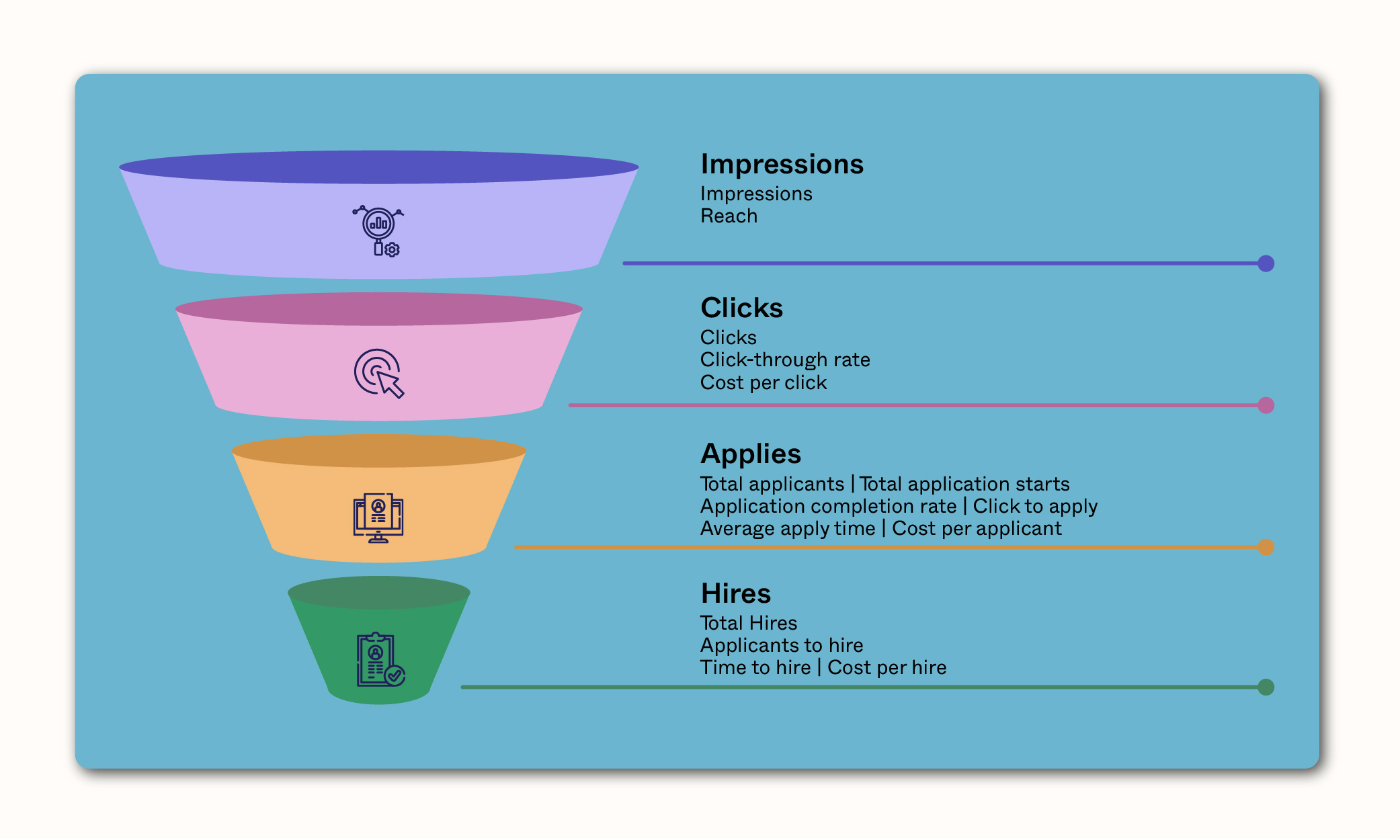
To determine what you should be looking at to measure your recruitment success, check out our blog, 17 Recruitment Advertising Metrics You Should Track for Hiring Success.
Let’s dive into the numbers, with the latest talent sourcing and recruitment advertising benchmarks!
Ready to Let the Data Do the Talking?
What are Some Essential Tools for Recruitment Advertising?
Talent sourcing is a true rat race – you can never afford to get complacent. And, recruitment advertising technologies are ever-evolving. So weeding out the “must-haves” from the “nice-to-haves” – not a straightforward task – is essential. Here’s a list of six of the best technologies available today to aid recruitment advertising:
We’re all guilty of it. When posting a job ad, we quickly lookup similar postings and replicate one that best suits the current opportunity. In case of a recurring requirement, we may even recycle an old ad – with a few tweaks at best if something has changed. While this is a perfectly harmless hack, recruiters often forget to check if job descriptions are entirely free of bias – whether racial, gender-related, cultural, religious, or otherwise. Inadvertently biased job descriptions can end up alienating high-quality candidates – a ZipRecruiter study found that gender-neutral job listings attract up to 42% more responses than their biased counterparts! In other words, recruiters must ensure that all job descriptions are wholly inclusive and unbiased to attract a more vast, diverse pool of relevant, high-quality talent. Get-Optimal, TalVista, and Textio are great technologies to help achieve this
Programmatic job advertising platforms
Programmatic job advertising is the practice of applying a machine learning-driven, rules-based approach to purchasing media for your job ads. Essentially, it automates the process of distributing your recruitment media spend, prioritizing top-performing job boards and other online publishers. Only the sources that attract the most relevant, high-quality candidates and produce the best results (whether applies or hires), at the most optimal cost, are kept in the mix. A data-driven, infinite loop of learning and improvement is a vital feature of this approach. Programmatic job advertising eliminates the need to manage several contracts to buy media separately from multiple publishers. It also makes it possible to use niche and effective job sites that recruiters may not even know about.
Click-to-apply conversion optimization
Once you’ve optimized your job descriptions and targeted the most relevant job seekers at the right place and cost, you’d think you’re done. But why aren’t all those clicks translating into applications? Because the job-seeker’s experience is broken. Glassdoor has found that the standard candidate drop-off rate in an application process is 80%! Luckily, conversion optimization technology can help you significantly increase your click-to-apply (conversion) rates by delivering a superior candidate experience. It helps simplify job applications, improve the information-gathering process, eliminate sign ups and logins if possible, optimize applications for all device types and sizes, limit mandatory questions to what’s truly necessary, and prevent external navigation, among other things. Conversion optimization can also help reengage job seekers that dropped off during an application using email, social, and selective advertising. Finally, you can use it to enable applications for multiple jobs, which increases the probability of a candidate applying to their best-fit job. Conversion optimization lets you achieve a significantly higher ROI from your existing candidate sources.
Chatbots
Modern, AI-powered chatbots offer another great way to drive conversion rates. Chatbots significantly enhance candidate experience by instantly addressing frequently asked questions, gathering information, screening candidates, scheduling interviews, and more, while keeping job-seekers engaged through the application process. This helps improve conversion rates while leaving TA leaders and recruiters free to focus on higher-value functions like interviewing and shortlisting candidates.
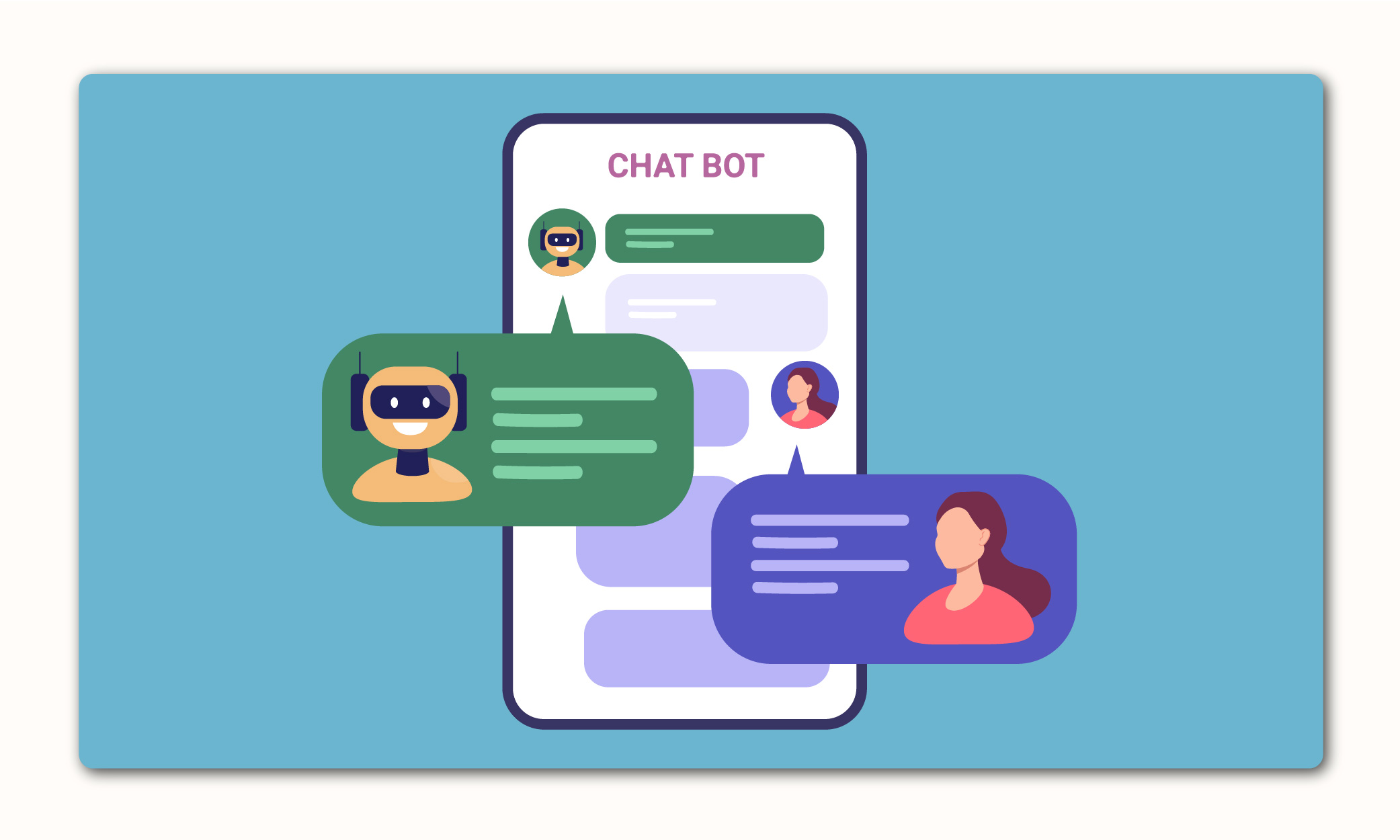
Applicant tracking system (ATS)
An ATS is software that centralizes the applicant management process, and helps gather, organize, analyze, and rank all the job applications received for open positions. An ATS that’s well-integrated with recruitment advertising technologies can help build and nurture robust talent pipelines and accelerate the time to fill open positions.
Candidate relationship management (CRM)
In today’s candidate-first recruitment market, recruiters need to make a concerted effort to effectively engage candidates and enhance their experience throughout the recruitment process. CRM software lets recruiters do just that by helping them engage, nurture, and manage candidates to build a talent pool that’s readily available when the time comes to fill positions. A great CRM captures all relevant candidate information and helps recruiters make detailed candidate profiles – critical to running successful ad campaigns. The wealth of candidate data gathered by CRMs can also be leveraged to craft highly-personalized communication, leading to faster conversion rates. Finally, CRM-generated talent pools make it possible to re-engage candidates, which is another way to quickly close out open positions.
Best Practices
Before you launch and execute your recruitment ad campaign, here are some best practices to keep in mind.
Opt for a multichannel approach
No single channel cuts it anymore when it comes to talent sourcing. You need an assortment of job boards, niche industry sites, social media, employee referrals, and anything else you can get your hands on to be able to find your perfect candidate. This is by no means a manual task.
Measure often
Don’t evaluate progress only upon campaign completion. Track results frequently. That way, you know early on whether or not something is working.
Measure right
Remember that your goals are not set in stone. If you realize something isn’t going according to plan, don’t be afraid to change your metrics – maybe you’re just looking at the wrong ones. Your metrics should work for you, not the other way around. Don’t waste time measuring things that aren’t relevant to your recruiting goals.
Optimize your application process
This means that applying should not only be as simple as possible (needing no more than a couple of clicks), it should also be mobile-optimized. Remember, most job seekers nowadays apply via their phones, so don’t risk putting them off by making it hard (or worse, impossible) for them to do so.
Get the job postings correct
Ensure that your job titles are appealing, accurate, and relevant. A majority of job searches are conducted by job title. Thus, job titles significantly impact the ranking of your job posting. (Even more so, on how it is perceived and which candidates apply.) Focus on highlighting niche skills, avoid abbreviations, and remember to highlight things that matter to candidates such as flexible work schedules, employment benefits, and so on.
Focus on the job description
Invest effort in drafting well-written job descriptions tailored to each position. Avoid generic job descriptions. Each job description must be tailored for the respective position. Also, remember to stick to the skills that are genuine must-haves. Overly long job descriptions can put off job seekers, resulting in lower conversions.
Eliminate bias from your job descriptions
Most job descriptions inadvertently introduce bias mainly in the form of discriminatory requirements. A biased job description dramatically limits the number of potential candidates it appeals to, as it makes diverse applicants feel left out. On the other hand, bias-free job descriptions can attract and engage even passive candidates.
Track to hire
Way too many employers stop tracking their recruitment advertising efforts at the application stage. They don’t realize that they need to track to hire to evaluate and improve their hiring process and outcomes accurately. It allows you to analyze your overall recruitment marketing performance for each applicant source – your career site, job boards, social media, search advertising, etc. Thus, allowing for intelligent prioritization of budgets for channels that deliver the most promising results.
To learn about Joveo’s award-winning programmatic job advertising platform, sign up for a free demo!
FAQs
How does recruitment advertising differ from traditional advertising?
Recruitment advertising is specifically targeted at attracting job seekers and promoting job openings, while traditional advertising focuses on promoting products or services to consumers. Recruitment advertising often requires different messaging and channels to reach its target audience effectively.
What are the key components of a successful recruitment advertising campaign?
A successful recruitment advertising campaign should have clear job descriptions, compelling job titles, targeted messaging, and a strong call-to-action. It should also be tailored to the specific audience and use the most effective channels to reach them.
How can data and analytics improve recruitment advertising efforts?
Data and analytics can help recruiters track the performance of their recruitment advertising campaigns, measure the effectiveness of different channels, and make data-driven decisions to optimize their advertising strategy in time. They can also help recruiters identify trends and patterns in candidate behavior to improve future campaigns.
What role does social media play in recruitment advertising?
Social media platforms are valuable tools for recruitment advertising, offering access to a large and diverse pool of potential candidates. They allow recruiters to showcase their employer brand, engage with passive candidates, and share job openings to attract qualified applicants.
Looking to streamline your recruitment efforts?
- Try our Job Description Optimizer for quick, effective job descriptions.
- Forecast your ad spend with the CPA Calculator.
- Need help choosing vendors? Explore our RFP Templates for expert guidance.
Also read:










